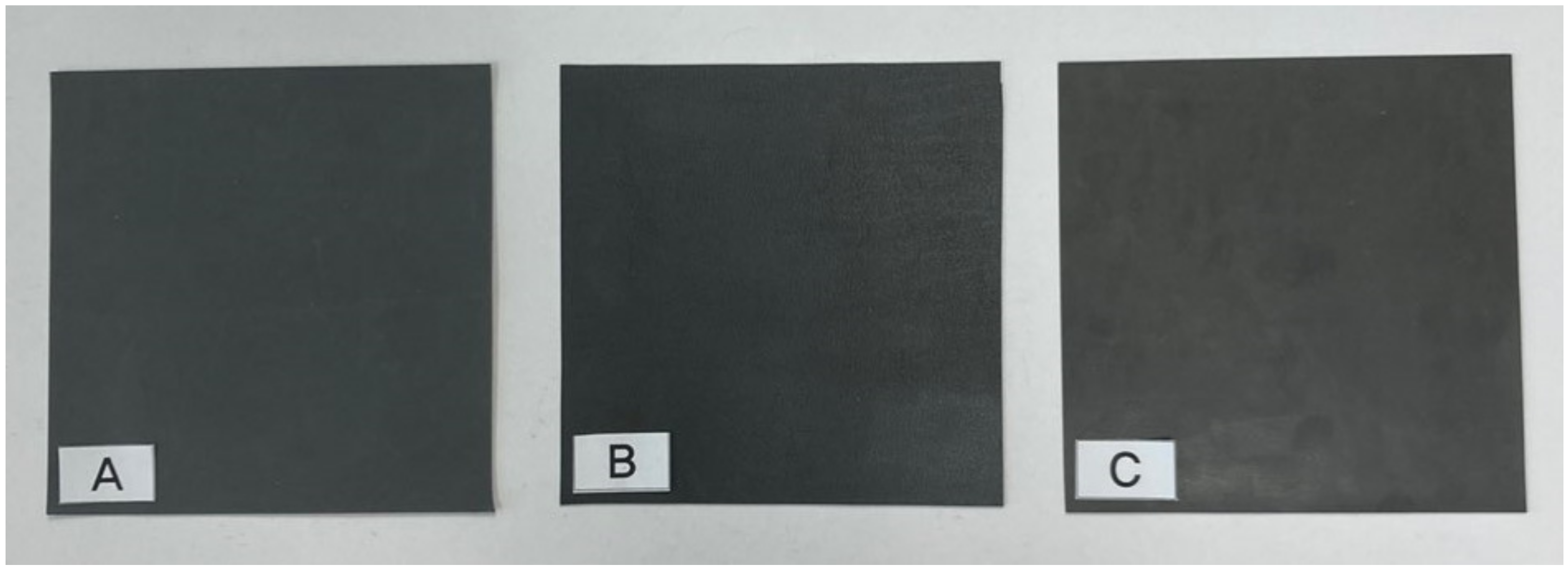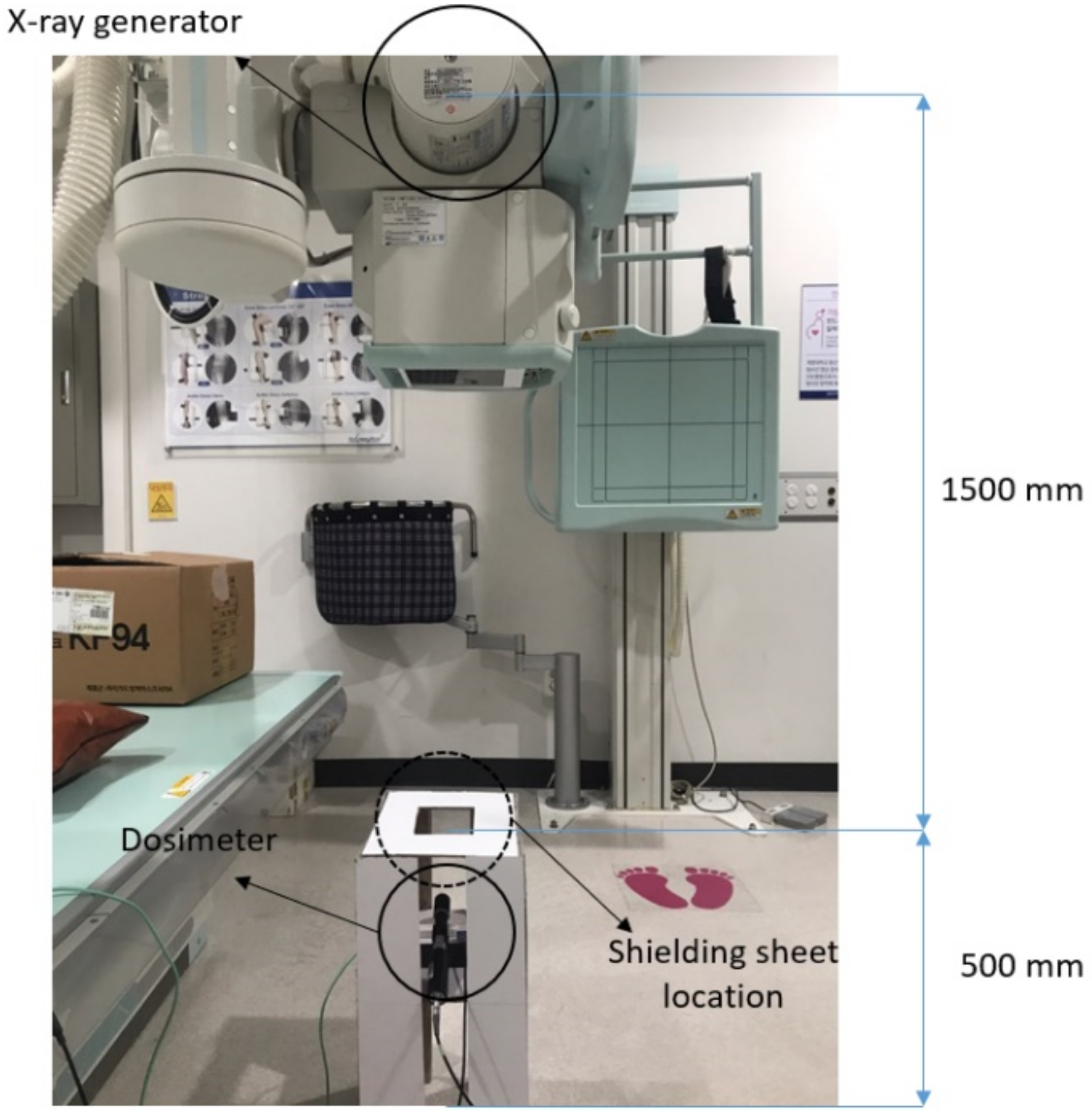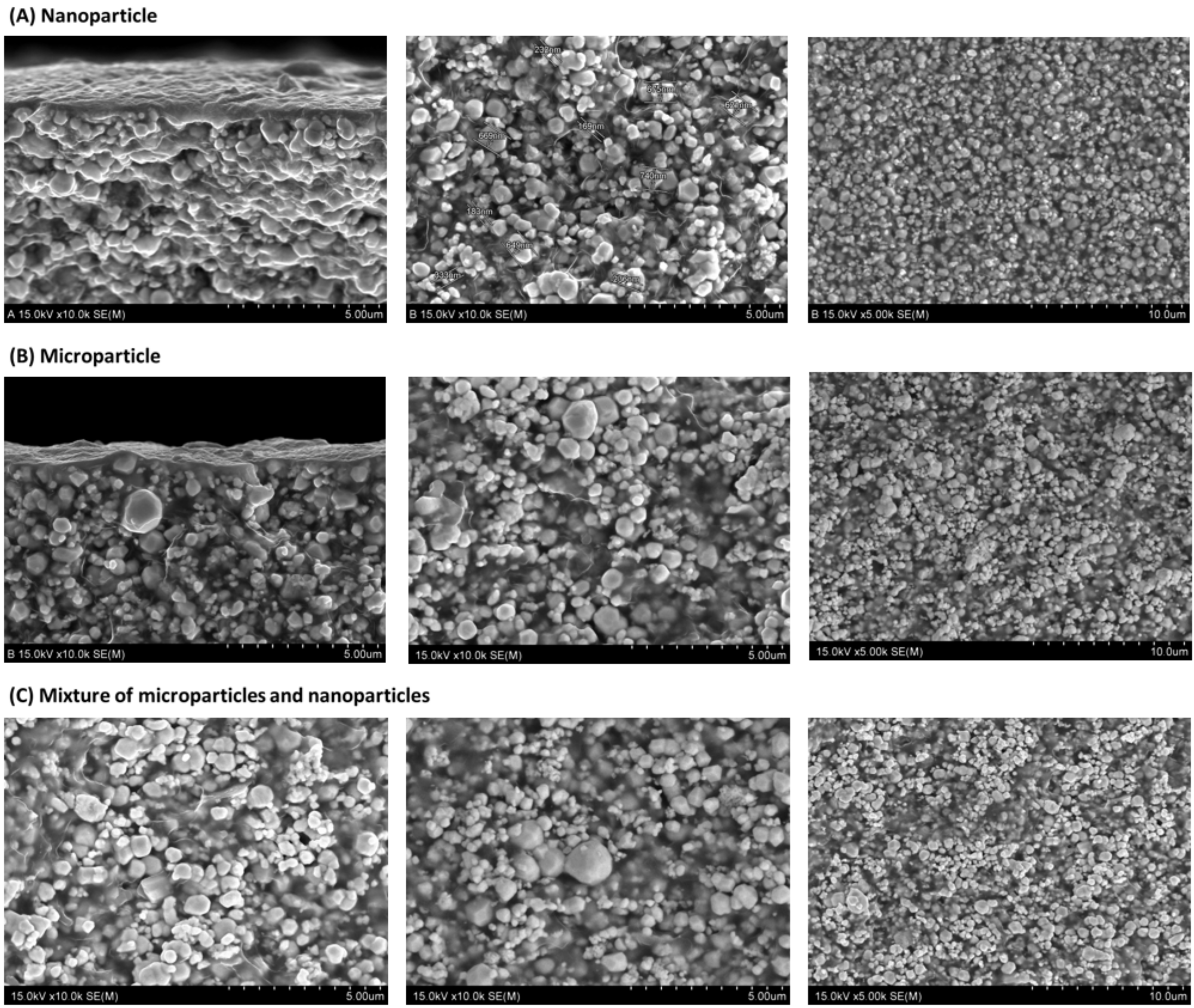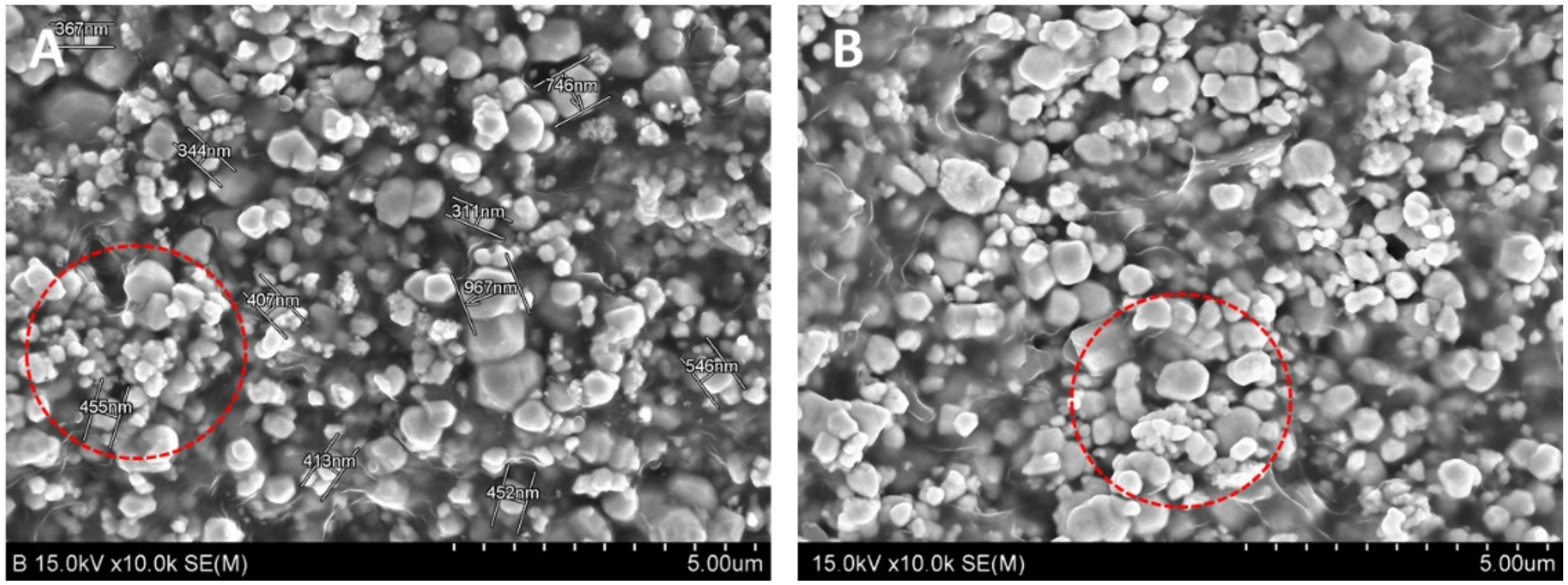Analysis of Shielding Performance of Radiation-Shielding Materials According to Particle Size and Clustering Effects
Abstract
1. Introduction
2. Materials and Methods
3. Results
4. Discussion
5. Conclusions
Funding
Institutional Review Board Statement
Informed Consent Statement
Data Availability Statement
Conflicts of Interest
References
- Kalra, M.K.; Maher, M.M.; Toth, T.L.; Hamberg, L.M.; Blake, M.A.; Shepard, J.; Saini, S. Strategies for CT Radiation Dose Optimization. Radiology 2004, 230, 619–628. [Google Scholar] [CrossRef]
- McCollough, C.H.; Leng, S. Use of artificial intelligence in computed tomography dose optimization. Ann. ICRP 2020, 49 (Suppl. 1), 113–125. [Google Scholar] [CrossRef]
- Roshani, M.; Phan, G.T.; Ali, P.J.M.; Roshani, G.H.; Hanus, R.; Duong, T.; Corniani, E.; Nazemi, E.; Kalmoum, E.M. Evaluation of flow pattern recognition and void fraction measurement in two phase flow independent of oil pipeline’s scale layer thickness. Alex. Eng. J. 2021, 60, 1955–1966. [Google Scholar] [CrossRef]
- Roshani, M.; Phan, G.; Faraj, R.H.; Phan, N.H.; Roshani, G.H.; Nazemi, B.; Corniani, E.; Nazemi, E. Proposing a gamma radiation based intelligent system for simultaneous analyzing and detecting type and amount of petroleum by-products. Nucl. Eng. Technol. 2021, 53, 1277–1283. [Google Scholar] [CrossRef]
- Golding, S.J.; Shrimpton, P.C. Radiation dose in CT: Are we meeting the challenge? Br. Inst. Radiol. 2002, 75, 1–4. [Google Scholar] [CrossRef]
- Gargan, L.; Picano, E. The risk of cumulative radiation exposure in chest imaging and the advantage of bedside ultrasound. Crit. Ultrasound J. 2005, 7, 1–4. [Google Scholar] [CrossRef] [PubMed]
- Livingstone, R.S.; Varghese, A.; Keshava, S.N. A Study on the Use of Radiation-Protective Apron among Interventionists in Radiology. J. Clin. Imaging Sci. 2018, 8, 1–4. [Google Scholar] [CrossRef]
- Warren-Forward, H.; Cardew, P.; Smith, B.; Clack, L.; McWhirter, K.; Johnson, S.; Wessel, K. A comparison of dose savings of lead and lightweight aprons for shielding of 99 m-Technetium radiation. Radiat. Prot. Dosimetry 2007, 124, 89–96. [Google Scholar] [CrossRef] [PubMed]
- Zuguchi, M.; Chida, K.; Taura, M.; Inaba, Y.; Ebata, A.; Yamada, S. Usefulness of non-lead aprons in radiation protection for physicians performing interventional procedures. Radiat. Prot. Dosimetry 2008, 131, 531–534. [Google Scholar] [CrossRef]
- Burns, K.M.; Shoag, J.M.; Kahlon, S.S.; Parsons, P.J.; Bijur, P.E.; Taragin, B.H.; Markowitz, M. Lead Aprons Are a Lead Exposure Hazard. J. Am. Coll. Radiol. 2016, 14, 641–647. [Google Scholar] [CrossRef] [PubMed]
- Shoag, J.M.; Burns, K.M.; Kahlon, S.S.; Parsons, P.J.; Bijur, P.E.; Taragin, B.H.; Markowitz, M. Lead poisoning risk assessment of radiology workers using lead shields. Arch. Environ. Occup. Health 2020, 75, 60–64. [Google Scholar] [CrossRef]
- Çetin, H.; Yurt, A.; Yüksel, S.H. The absorption properties of lead-free garments for use in radiation protection. Radiat. Prot. Dosimetry 2017, 173, 345–350. [Google Scholar] [CrossRef] [PubMed]
- AbuAlRoos, N.J.; Azman, M.N.; Amin, N.A.B.; Zainon, R. Tungsten-based material as promising new lead-free gamma radiation shielding material in nuclear medicine. Phys. Med. 2020, 78, 48–57. [Google Scholar] [CrossRef] [PubMed]
- KIM, S.C. Development of air pressure mirroring particle dispersion method for producing high-density tungsten medical radiation shielding film. Sci. Rep. 2021, 11, 1–10. [Google Scholar] [CrossRef]
- Nambiar, S.; Yeow, T.T.W. Polymer-Composite Materials for Radiation Protection. ACS Appl. Mater. Interfaces 2012, 4, 5717–5726. [Google Scholar] [CrossRef]
- McCaffrey, J.P.; Mainegra-Hing, E.; Shen, H. Optimizing non-Pb radiation shielding materials using bilayers. Med. Phys. 2009, 36, 5586–5594. [Google Scholar] [CrossRef]
- Monaco, M.G.L.; Carta, A.; Tamhid, T.; Porru, S. Anti-X Apron Wearing and Musculoskeletal Problems among Healthcare Workers: A Systematic Scoping Review. Int. J. Environ. Res. Public Health 2020, 17, 5877. [Google Scholar] [CrossRef]
- Li, R.; Gu, Y.; Wang, Y.; Yang, Z.; Li, M.; Zhang, Z. Effect of particle size on gamma radiation shielding property of gadolinium oxide dispersed epoxy resin matrix composite. Mater. Res. Express 2017, 4, 1–19. [Google Scholar] [CrossRef]
- Feng, F.X.; Mai, Y. Effects of particle size, particle/matrix interface adhesion and particle loading on mechanical properties of particulate–polymer composites. Compos. Part B 2008, 39, 933–961. [Google Scholar] [CrossRef]
- Yu, D.; Shu-Quan, C.; Hong-Xu, Z.; Chao, R.; Bin, K.; Ming-Zhu, D.; Yao-Dong, D. Effects of WO3 Particle Size in WO3/Epoxy Resin Radiation Shielding Material. Chin. Phys. Lett. 2012, 29, 1–5. [Google Scholar] [CrossRef]
- Kim, S.C.; Cho, S.H. Analysis of the Correlation between Shielding Material Blending Characteristics and Porosity for Radiation Shielding Films. Appl. Sci. 2019, 9, 1765. [Google Scholar] [CrossRef]
- Sattar, M.A.K.A.; Mkhaiber, A.F.; Majeed, A.M.A. Study of the effect of using nanomaterial in radiological shielding. AIP Conf. Proc. 2019, 2190, 1–8. [Google Scholar] [CrossRef]
- Hong, J.W.; Kim, D.H.; Kim, S.W.; Choi, S.H.; Lee, G.E.; Seo, H.K.; Kim, S.H.; Lee, Y.J. Effectiveness evaluation of self-produced micro- and nanosized tungsten materials for radiation shielding with diagnostic X-ray imaging system. Optik 2018, 172, 760–765. [Google Scholar] [CrossRef]
- Al-Dhuhaibat, M.J.R. Study of the shielding properties for some composite materials manufactured from polymer epoxy supported by cement, aluminum, iron and lead against gamma rays of the cobalt radioactive source (Co-60). Int. J. Appl. Innov. Eng. Manag. 2015, 4, 90–98. [Google Scholar]
- Botelho, M.Z.; Künzel, R.; Okuno, E.; Levenhagen, R.S.; Basegio, T.; Bergmann, C.P. X-ray transmission through nanostructured and microstructured CuO materials. Appl. Rad. Isot. 2011, 69, 527–530. [Google Scholar] [CrossRef] [PubMed]
- Al-Buriahi, M.S.; Sriwunkum, C.; Arslan, H.; Tonguc, B.T.; Bourham, M.A. Investigation of barium borate glasses for radiation shielding applications. Appl. Phys. A 2020, 126, 1–9. [Google Scholar] [CrossRef]
- AbuAlRoos, N.J.; Amin, N.A.B.; Zainon, R. Conventional and new lead-free radiation shielding materials for radiation protection in nuclear medicine: A review. Rad. Phys. Chem. 2019, 165, 1–7. [Google Scholar] [CrossRef]
- Moitra, A.; Kim, S.; Kim, S.-G.; Park, S.J.; German, R.M.; Horstemeyer, M.F. Investigation on sintering mechanism of nanoscale tungsten powder based on atomistic simulation. Acta Mater. 2010, 58, 3939–3951. [Google Scholar] [CrossRef]
- Amirkhanlou, S.; Ketabchi, M.; Parvin, N. Nanocrystalline/nanoparticle ZnO synthesized by high energy ballmilling process. Mater. Lett. 2012, 86, 122–124. [Google Scholar] [CrossRef]
- Cho, J.H.; Kim, M.S.; Rhim, J.D. Comparison of radiation shielding ratios of nano-sized bismuth trioxide and molybdenum. Rad. Eff. Def. Sol. 2015, 170, 651–658. [Google Scholar] [CrossRef]
- Abdo, A.E.-S.; Ali, M.A.M.; Ismail, M.R. Natural fibre high-density polyethylene and lead oxide composites for radiation shielding. Rad. Phys. Chem. 2003, 66, 185–195. [Google Scholar] [CrossRef]
- Kang, J.H.; Oh, S.H.; Oh, J.I.; Kim, S.H.; Choi, Y.S.; Hwang, E.H. Protection evaluation of non-lead radiation-shielding fabric: Preliminary exposure-dose study. Oral Radio. 2019, 35, 224–229. [Google Scholar] [CrossRef] [PubMed]
- Papadopoulos, N.; Papaefstathiou, C.; Kaplanis, P.A.; Menikou, G.; Kokona, G.; Kaolis, D.; Yiannakkaras, C.; Christofides, S. Comparison of Lead-free and Conventional x-ray aprons for Diagnostic Radiology. IFMBE Proc. 2009, 25, 544–546. [Google Scholar] [CrossRef]
- Youssef, Y.M.; Dashwood, R.J. Effect of clustering on particle pushing and solidification behaviour in TiB2 reinforced aluminium PMMCs. Comp. Part A Appl. Sci. Manufac. 2005, 36, 747–763. [Google Scholar] [CrossRef]
- Fornalski, K.W. Simple empirical correction functions to cross sections of the photoelectric effect, Compton scattering, pair and triplet production for carbon radiation shields for intermediate and high photon energies. J. Phys. Commun. 2018, 2, 1–11. [Google Scholar] [CrossRef]
- PnaTTt, R.H. Atomic Photoelectric Effect at High Energies. Phys. Rev. 1960, 117, 1017–1028. [Google Scholar] [CrossRef]
- Yu, H.; Chen, X.; Zhou, Y.; Chen, D.; Zhang, L. Impact of photoelectric effect on X-ray density logging and its correction. Appl. Rad. Isot. 2020, 156, 1–22. [Google Scholar] [CrossRef]
- Haber, F.E.; Froyer, G. Transparent polymers embedding nanoparticles for X-rays attenuation. J Univ. Chem. Tech. Metal. 2008, 43, 283–290. [Google Scholar]
- Kalkornsurapranee, E.; Kothan, S.; Intom, S.; Johns, J.; Kaewjaeng, S.; Kedkaew, C.; Chaiphaksa, W.; Sareein, T.; Kaewkhao, J. Wearable and flexible radiation shielding natural rubber composites: Effect of different radiation shielding fillers. Rad. Phys. Chem. 2020, 179. [Google Scholar] [CrossRef]
- Azman, N.Z.N.; Siddiqu, S.A.; Low, I.M. Characterisation of micro-sized and nano-sized tungsten oxide-epoxycomposites for radiation shielding of diagnostic X-rays. Mater. Sci. Eng. C 2013, 33, 4952–4957. [Google Scholar] [CrossRef]






| Microparticle | Nanoparticle | |
|---|---|---|
| Particle size distribution () | 100–400 | 0.4–0.9 |
| Specific surface area (m2/g) | 24.45–31.2 | 8.5–10.5 |
| Tap density (g/cc) | 5.2–7.2 | 2.5–3.7 |
| Purity (%) | 99–99.8 | 99–99.8 |
| Item | Value | ||
|---|---|---|---|
| A | B | C | |
| Sheet structure | Single structure | ||
| Shielding material | Tungsten | ||
| Mixing ratio (polymer: tungsten) | 1:3 | ||
| Sheet weight (kg/m2) | 1.0 | 1.2 | 1.1 |
| Sheet thickness (mm) | 0.30 ± 0.005 | 0.32 ± 0.005 | 0.31 ± 0.005 |
| Solvents (g) | 11.2 | 12.1 | 11.4 |
| Polyethylene (g) | 23.4 | 22.5 | 25.1 |
| Tungsten (g) | 70.2 | 76.4 | 73.1 |
Publisher’s Note: MDPI stays neutral with regard to jurisdictional claims in published maps and institutional affiliations. |
© 2021 by the author. Licensee MDPI, Basel, Switzerland. This article is an open access article distributed under the terms and conditions of the Creative Commons Attribution (CC BY) license (https://creativecommons.org/licenses/by/4.0/).
Share and Cite
Kim, S.-C. Analysis of Shielding Performance of Radiation-Shielding Materials According to Particle Size and Clustering Effects. Appl. Sci. 2021, 11, 4010. https://doi.org/10.3390/app11094010
Kim S-C. Analysis of Shielding Performance of Radiation-Shielding Materials According to Particle Size and Clustering Effects. Applied Sciences. 2021; 11(9):4010. https://doi.org/10.3390/app11094010
Chicago/Turabian StyleKim, Seon-Chil. 2021. "Analysis of Shielding Performance of Radiation-Shielding Materials According to Particle Size and Clustering Effects" Applied Sciences 11, no. 9: 4010. https://doi.org/10.3390/app11094010
APA StyleKim, S.-C. (2021). Analysis of Shielding Performance of Radiation-Shielding Materials According to Particle Size and Clustering Effects. Applied Sciences, 11(9), 4010. https://doi.org/10.3390/app11094010






